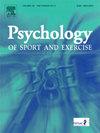Athletic identity and autonomous motivation as predictors of endurance performance during high intensity exercise
IF 3.3
2区 心理学
Q2 HOSPITALITY, LEISURE, SPORT & TOURISM
引用次数: 0
Abstract
Purpose
The aims of the present study were a) to develop and test a within-person experimental manipulation of athletic identity salience and autonomous motivation in endurance contexts, and b) to examine whether athletic identity or autonomous motivation better predicted endurance performance via the desire to reduce effort and the value of the performance goal.
Methods
Thirty-seven participants (24 males, 13 females, 20–27 years old) from a sports background completed a brief performance profile activity to identify and evaluate personal characteristics that would help during an endurance task (experimental condition) or described how they maintained close relationships (control condition). After completing measures of athletic identity and autonomous motivation, participants then completed an incrementally difficult cycling test until voluntary termination. The intensity of the test increased every 150 s, with measures of desire to reduce effort and performance goal value taken during each stage.
Results
Multilevel modelling revealed that the experimental manipulation enhanced the salience of athletic identity (b = 05, p = .005), but did not change autonomous motivation (b = .05, p = .21). However, differences in endurance performance were explained by within-person changes in autonomous motivation (b = 31.02, p < .001), but not athletic identity (b = −5.34, p = .58). This direct effect was partially mediated by smaller decreases in the value of the performance goal (z = 3.45, p < .001).
Conclusion
A modified performance profile is useful to experimentally manipulate the salience of athletic identity in endurance contexts. Autonomous motivation enhances endurance performance by minimising reductions in the motivational value of the performance goal.
运动认同与自主动机作为高强度运动中耐力表现的预测因子。
目的:本研究的目的是:a)开发和测试耐力情境下运动认同显著性和自主动机的个人实验操作;b)检验运动认同或自主动机是否通过减少努力的愿望和表现目标的价值更好地预测耐力表现。方法:37名运动背景的参与者(24名男性,13名女性,20 - 27岁)完成了一项简短的表现描述活动,以确定和评估有助于耐力任务(实验条件)或描述他们如何维持亲密关系(对照组条件)的个人特征。在完成运动员身份和自主动机的测量后,参与者完成了一项难度逐渐增加的自行车测试,直到自愿终止。测试的强度每150秒增加一次,并在每个阶段测量减少努力和性能目标值的愿望。结果:多层次模型显示,实验操作增强了运动身份的显著性(b = 05, p = 0.005),但没有改变自主动机(b = 0.05, p = 0.21)。然而,耐力表现的差异可以用自主动机的个人内部变化来解释(b = 31.02, p < .001),但不能用运动身份来解释(b = -5.34, p = .58)。这种直接影响部分是由性能目标值的较小下降所介导的(z = 3.45, p < .001)。结论:一种改良的运动表现档案有助于在实验上操纵耐力情境下运动身份的显著性。自主激励通过最小化绩效目标的激励价值来提高耐力表现。
本文章由计算机程序翻译,如有差异,请以英文原文为准。
求助全文
约1分钟内获得全文
求助全文
来源期刊
CiteScore
6.40
自引率
5.90%
发文量
172
审稿时长
69 days
期刊介绍:
Psychology of Sport and Exercise is an international forum for scholarly reports in the psychology of sport and exercise, broadly defined. The journal is open to the use of diverse methodological approaches. Manuscripts that will be considered for publication will present results from high quality empirical research, systematic reviews, meta-analyses, commentaries concerning already published PSE papers or topics of general interest for PSE readers, protocol papers for trials, and reports of professional practice (which will need to demonstrate academic rigour and go beyond mere description). The CONSORT guidelines consort-statement need to be followed for protocol papers for trials; authors should present a flow diagramme and attach with their cover letter the CONSORT checklist. For meta-analysis, the PRISMA prisma-statement guidelines should be followed; authors should present a flow diagramme and attach with their cover letter the PRISMA checklist. For systematic reviews it is recommended that the PRISMA guidelines are followed, although it is not compulsory. Authors interested in submitting replications of published studies need to contact the Editors-in-Chief before they start their replication. We are not interested in manuscripts that aim to test the psychometric properties of an existing scale from English to another language, unless new validation methods are used which address previously unanswered research questions.

 求助内容:
求助内容: 应助结果提醒方式:
应助结果提醒方式:


